Good product descriptions can significantly affect the profits generated by an online store. So how to create them so that they translate into high sales? What mistakes to avoid? In this article you will learn 18 useful tips.
Good product description – why is it so important?
.
There are many reasons why you should make sure you have the best possible product descriptions. The first is to increase conversions. If you present your offerings properly, customers will get answers to their most important questions and will have no doubts about whether they should actually make a purchase.
Another reason is increased traffic – unique product descriptions are also original content that Google will pay attention to. If the content included attracts attention, it will positively affect the amount of time spent on the site, bounce rate and other SEO-important metrics.
Finally, it is worth mentioning that good descriptions will help stand out from the competition. With their help, you can even develop a unique style that will make your store particularly recognizable.
So let’s get down to specifics about how to create product descriptions.
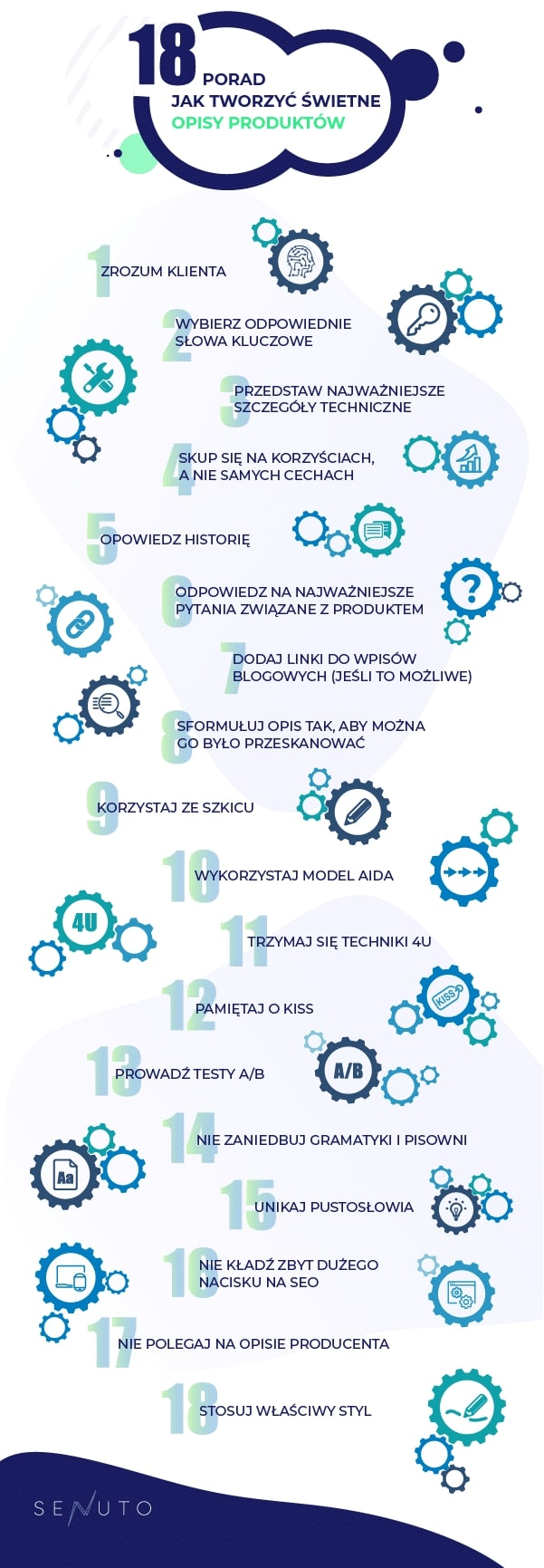 .
.
1. Understand your customer
.
To create the best possible product descriptions, you need to know your target audience to begin with. So create a so-called customer persona. This includes such information as:
-
Demographics -gender, age, place of residence, education and job.
- .
-
Habits -what activities does the target customer indulge in?
-
Needs -what goals does the target customer want to achieve?
-
Fears -what does he fear and why does he want to avoid it?
- .
.
.
Refer to them in your product description. Also answer the following questions in the text:
-
Why is the product better than those offered by competitors?
.
-
How does it meet customer needs?
-
Why don’t other products that customers may have been looking for work?
.
.
Clearly defining your target audience will also help you develop the right style. After all, you will be addressing teenagers looking for fashionable clothes in a different way than business customers doing bulk orders.
2. Choose the right keywords
.
Product descriptions need to be optimized for phrases that customers actually type into Google. However, it’s not enough to just weave in the main phrase that you’re preparing the description for. The text should also include additional keywords that relate to your chosen product.
To find them, conduct a simple keyword research. You can find useful features in Senuto in the Keyword Database module. Take advantage of the Dependent Words report:
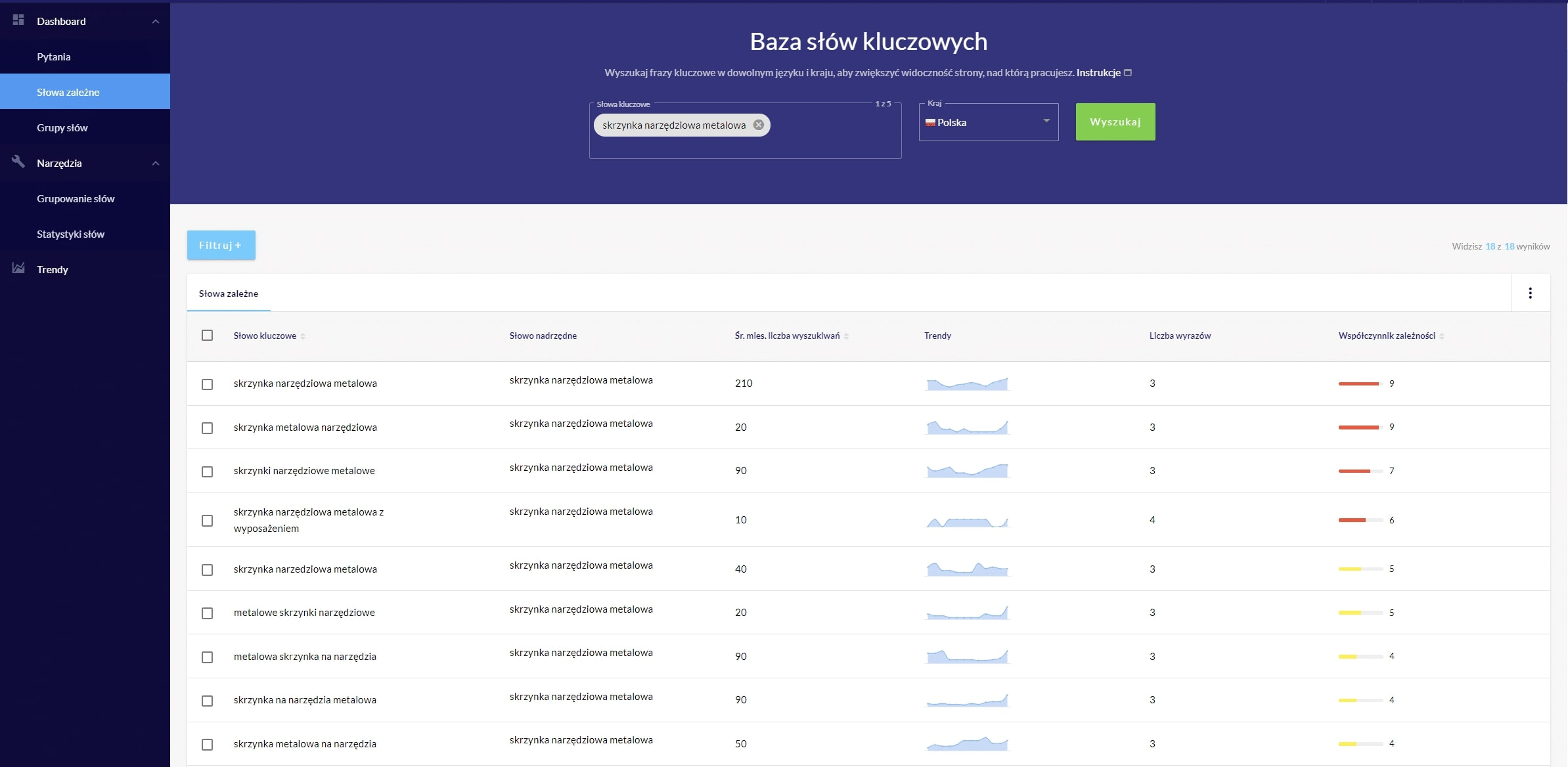
Suppose you were to prepare descriptions of metal toolboxes. A quick analysis shows us many more related phrases. Of course, not all of them will fit the products you are to present. So let’s focus on the key phrase metal toolbox with equipment. If you hover over them, a magnifying glass icon will appear:

When you click it, you will be taken to a separate subpage presenting useful information related to this phrase:
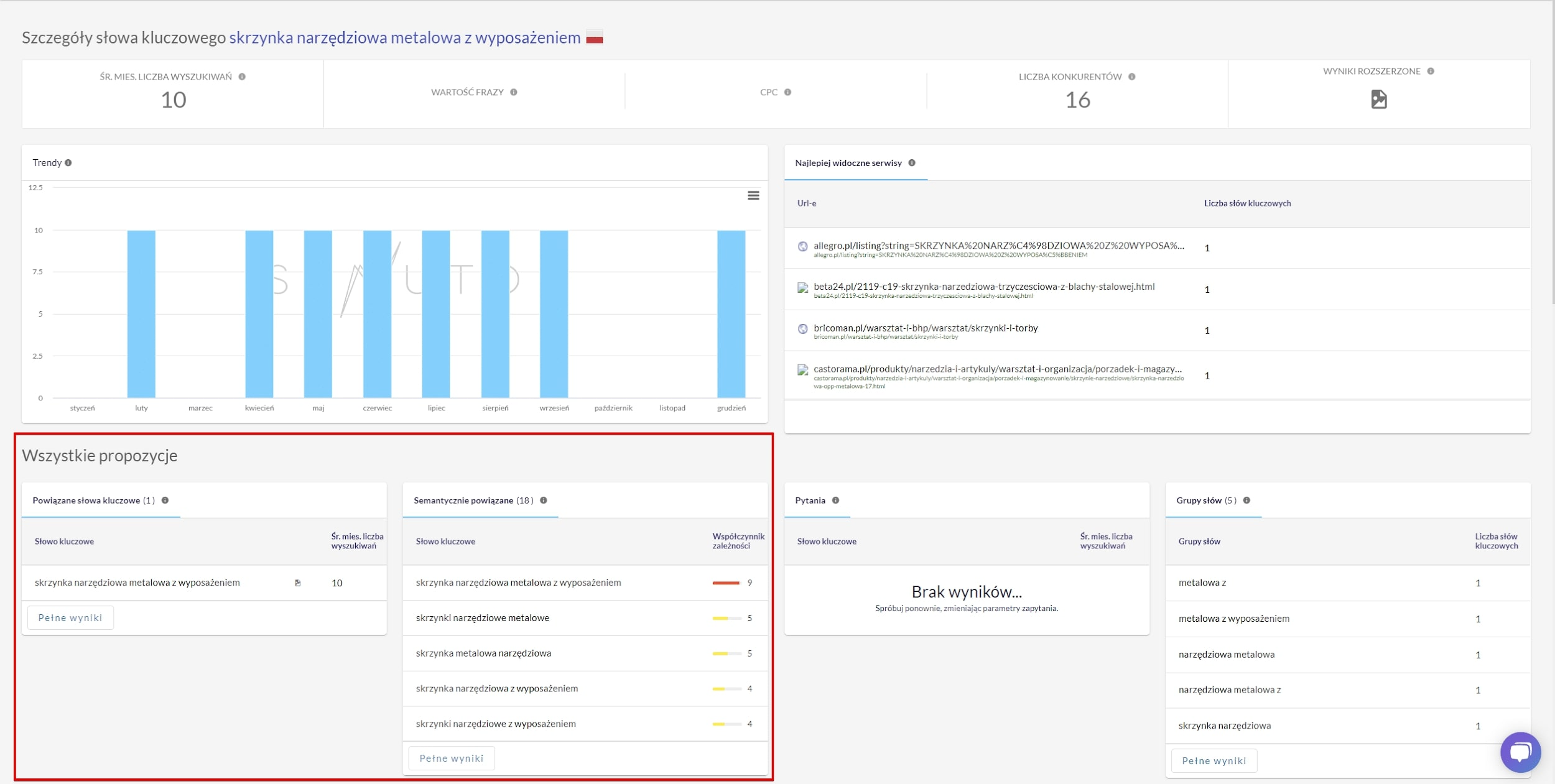
Of particular note are Related Keywords and Semantically Related. The latter will allow you to enrich your descriptions with additional, meaningfully connected words. This will make them sound more natural and allow you to position your products for many more phrases.
When doing keyword research, pay attention to the following:
-
Average monthly number of searches – of course, the more, the better, however, popularity is also related to competitiveness.
- .
-
Number of competitors – this statistic will give you a more accurate insight into what the aforementioned competitiveness of popular phrases looks like.
-
Dependency Ratio (by Semantically Related) – the larger, the better. Quite quickly you can see that as this value decreases, the next related phrases are already more semantically distant from the target one.
- .
.
3. Provide key technical details
.
This is a very important part of the description. Customers will not always be able to imagine how the product physically presents itself. In the case of certain goods (e.g., electronics), technical specifications are all the more important, as they help make an informed buying decision. Here’s an example of details worth including in the description:
-
Size
.
-
Weight
.
-
Dimensions
.
-
Materials
-
Certificates
.
-
Power consumption
-
Manufacturing year
.
If certain details further raise questions, try to explain the issue in a more accessible way. Some clothing stores include information about the recommended height and weight for a particular size of clothing. To get an idea of the size of the item, you can compare it to the size of something familiar from everyday use (such as a water bottle, credit card, etc.).
If you provide technical data, it is essential to present it in an easy-to-read form. The descriptions of listings on Allegro are very good in this regard:
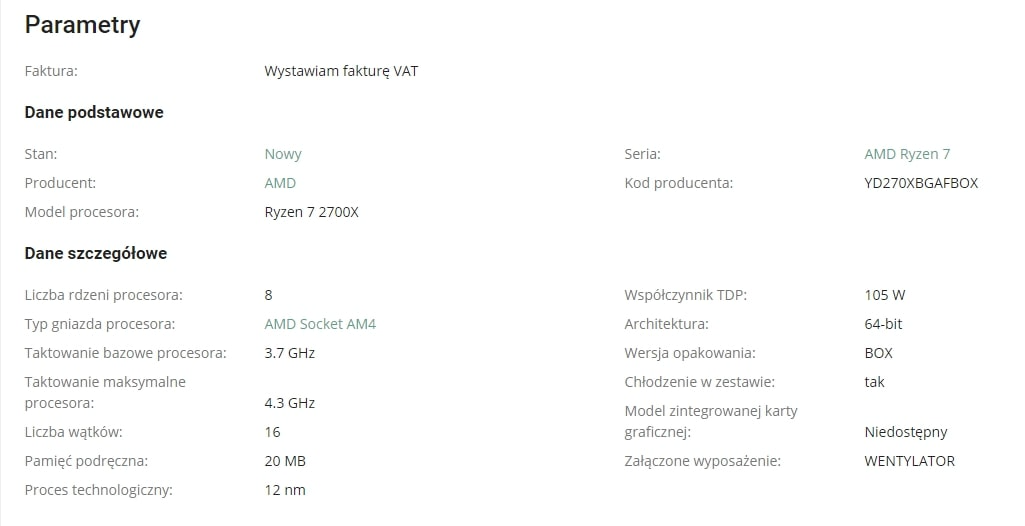
This format makes the information readable and easy to scan. Potential customers can also quickly find the technical detail they are interested in.
4. Focus on the benefits, not the features themselves
.
In the world of marketing and sales, the importance of benefit language is very often emphasized.
In short, it’s about visualizing how how a product and its features will help the buyer. This approach contrasts with “dry” listing of features and technical details. As I mentioned above, such information is very important and cannot be ignored – we rely on it. However, they should not constitute the entire product description.
So how to write in the language of benefits? Here’s a simple tip – after listing a specific feature, expand its description, starting with “why“. Here are some examples of how to turn a feature into a benefit:
-
The shoes are made of durable material, thanks to which they will last you for many years and you won’t have to replace them quickly.
-
The graphics card is equipped with 8 GB of memory, so you’ll be able to enjoy high image resolution and smoothness in even the most demanding games.
-
The bag is very lightweight, so you’ll be able to wear it on your shoulder with no problem, even all day.
- The bag is very lightweight, so you’ll be able to wear it on your shoulder without any problem.
It’s easy to forget to write like this. Focusing on the benefits requires you to empathize with the potential customer’s position and imagine how the product will improve their lives in everyday situations.
And then there’s a brief piece of advice based on psychology. People in most cases exhibit what is known as loss aversion. In a nutshell, it consists in the fact that it will be more fortunate to, for example, avoid a loss of 100 zlotys than to gain an additional 100 zlotys. Therefore, in a product description based on benefit language, it is worth pointing out how a feature helps the customer avoid problems. Following this principle, let’s rephrase the earlier example of a graphics card description:
-
The graphics card is equipped with 8 GB of memory, so that in the latest games you won’t have to choose lower details and tire with frequent drops in smoothness of the image.
I will already point out that if you were to remember from this article the most important tip for writing product descriptions, it is this ????.
5. Tell a story
.
It’s a good idea to use storytelling in your product descriptions. In marketing, this term means using narrative to convey a specific message. The goal is to evoke feelings in the recipient that he or she will be able to identify with, which will thenspur him or her to take action, or in this case, buy the product. Remember that telling such a story requires empathy.
This is best explained with an example. Suppose you sell office supplies. The main character in the story is an accountant who manages numerous documents. Over time, so many of them accumulate on her desk that it negatively affects her work comfort. Because of this disorder, she begins to make serious mistakes in her work and causes herself unnecessary nerves. Eventually, she decides that she needs to equip herself with the right tools to better organize her work.
So she acquires the product you describe (e.g., a document binder), so that she saves herself the earlier problems, and her work life changes for the better. In this way, you will make it clear that it is thanks to the product in question that this problem has been solved.
When creating such stories, you need to keep the right balance. A universal story will reach a larger group of people, but it won’t make as much of an impression as storytelling focused on a precisely targeted audience. How you approach this will already depend on the product itself – some are aimed at a wide range of customers, while others are actually designed for narrowed needs.
.
One study conducted by Forrester found that 55% of people are willing to abandon a product in an online store if they are unable to find the answer to an important question related to it. According to 77% of respondents, respecting customers’ time is one of the best things a company can do.
So when creating a product description, find out what questions users type into Google. You’ll check this in Senuto’s Keyword Database in the Queries report. You can answer them in the main part of the description or prepare a separate FAQ section – this way you will make your content even more readable and accessible.
7. Add links to blog posts (if possible)
.
Product descriptions should comprehensively present your offerings, but should not exhaust potential customers ????. If you would like to give them a more elaborate presentation of an issue, it would be better to refer them to other content. In this way, you can even convince them of the offer if they are initially unsure if it really suits them with the product.
Examples of topics could include issues such as:
-
A guide on how to use the product and how to take care of it.
- .
-
Detailed instructions for assembly/installation.
-
Description of product development history.
- Detailed instructions for installation/installation.
-
List of similar products and their detailed comparison.
List of similar products and their detailed comparison.
Such a procedure will not only increase the chance that a customer will buy the product, but also improve the SEO of the store itself. Internal linking can help the site’s positioning and positively affect the user experience.
Remember! The main goal of a product page is conversion – the action expected of the customer is to buy the goods. If you refer him to a blog article, for example, take care of 3 things:
- The link shouldopen a new subpage, not replace the product page that the potential customer is currently viewing.
- Let it only be content that will help him/her make a buying decision.
- From the blog, send the user back to the product page.
.
.
.
8. Format the description so that it can be scanned
.
Most Internet users do not read everything they encounter on the Web. Such habits were observed as early as 1997, and repeated studies have shown that too much in this regard has not changed in recent years. We usually scan content, trying to catch the most important information in it.
Keep this in mind when writing product descriptions. Include the most important information in striking headlines. This is where you emphasize the benefits. Include less important details in bulleted lists. Don’t allow potential customers to have to wade through long, unreadable blocks of text. Subsequent paragraphs do not need to be elaborate. Different fonts and other embellishments like bolden and cursive are also a good way to make specific information stand out.
Note the following example:
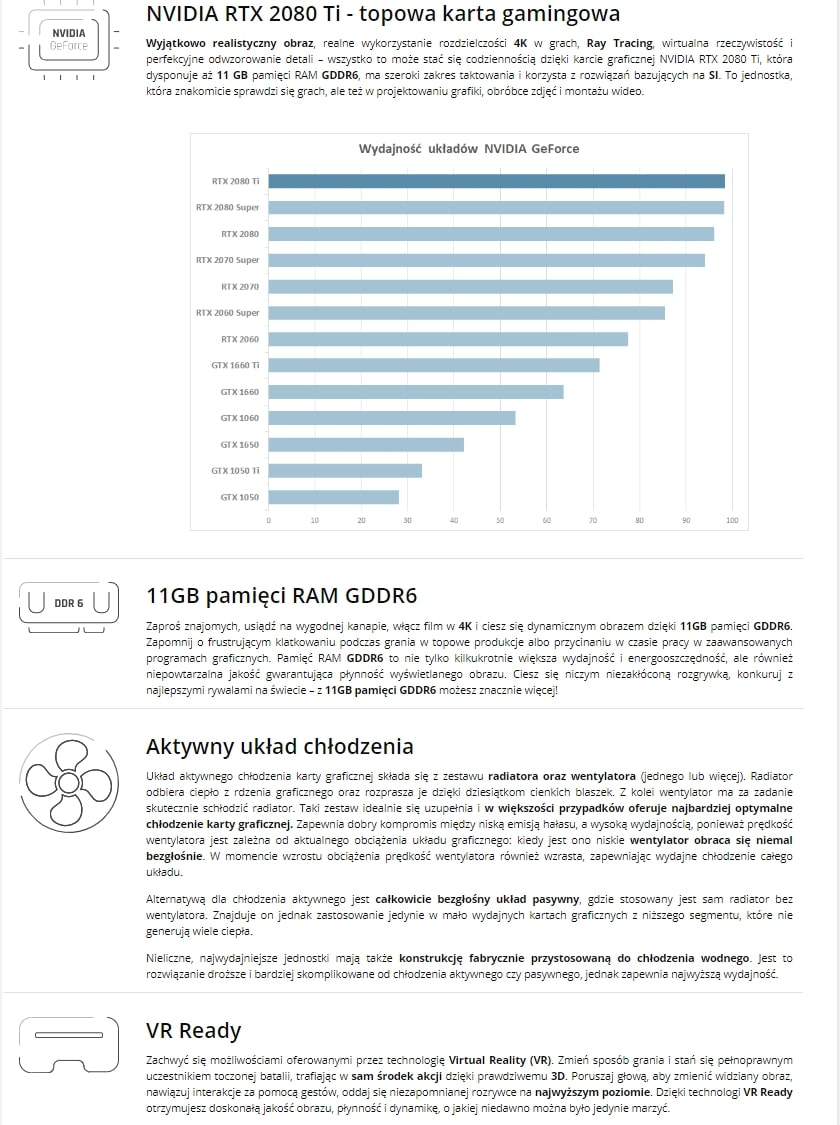
Here is part of the extended description of the Nvidia RTX 2080 Ti graphics card. The most important information is listed in the following headings enriched with icons. Paragraphs are divided in such a way that the whole text is easy to scan. In addition, the most important information relevant to those customers who care about the highest possible performance and convenience is bolded – 4K, 11 GB of GDDR6 memory, completely silent passive chip, etc.
9. Use a sketch
.
Now that you know how to get down to creating product descriptions, it’s a good idea to prepare well for this task. So make yourself a list that includes a description of your target customer’s personality, key keywords, features and product benefits. On this basis it will also be easier for you to prepare an attention-grabbing story and think about what questions about the product the customer might have, and therefore what content to refer him to.
A sample outline might look like the following:
- A headline that grabs attention.
- A short paragraph describing the most important benefits of the product.
- A bulleted list outlining the features along with a further elaboration of the benefits provided.
- The most important technical data.
- Social proof.
- Call to action – the final incentive to purchase the product.
.
.
.
.
.
.
Of course, you can customize the template in any way you want – it all depends on your target audience, product categories, etc. It’s worth preparing even a few such templates for yourself.
Worth reading: Category descriptions. How to write them to sell?.
If the list of items you want to focus on is quite long, focus on the most important things at the very beginning. When you start writing, don’t worry about grammar and structure issues – that will come later. Try to be as enthusiastic as possible about creating a description, so that you can then polish it to its best state.
10 Use the AIDA model
.
There are many techniques to be found in marketing – one of the most popular and proven is content creation using the AIDA model. The acronym expands as follows:
- Attention (catching attention) – even if the product itself is very good, and the main part of the description is really selling, it will be of little use if the potential customer does not pay attention to the offer at all.
- Interest (interest) – once you manage to grab attention, you need to sustain the potential customer’s interest for a longer period of time to convince him to buy.
- Desire (desire) – once you have caught the attention of the recipient, directly draw attention to their needs and desires and how the product you describe can satisfy them.
- Action (action) – encourage them to take action, or in this case, purchase the product.
.
.
.
.
Let’s take a closer look at the individual steps:
Attention.
To grab attention, you must first of all know your target audience. Specific customer persona and knowledge of their needs and problems will be useful here.
Interest.
For your product description to successfully sustain interest, you need to give readers a reason to do so.
To do so, it’s worth pointing out how the problem they’re facing negatively affects their lives. Use mentioned storytelling for this purpose. Remember that the key at this stage is to present the problem in such a personal way, as if you were addressing the customer in question exclusively.
Desire
Carefully illustrate how your product will help meet the needs of your target audience. Explain how their lives can be improved in terms of health, well-being, financial gain, etc. If you approach this task well, the potential customer will already be ready to buy at this stage.
Action.
As the marketing adage goes – always be closing. Convince the potential customer to take immediate action. Point out, for example, that as a result of procrastination, his problem will continue to persist. If the buying process itself is a bit more complex, it’s worth clarifying any doubts just then.
11 Stick to the 4U technique
.
4U is another technique that helps you create salesy content. The acronym stands for:
- Unique – uniqueness
- Ultra-specific – accuracy
- Useful – usefulness
- Urgent – urgency
.
.
.
.
Let’s take a closer look at each element:
Unique.
Emphasize the uniqueness of the product. Highlight what makes it different from other similar ones, even if it is just one small feature.
Ultra-specific.
Provide maximally precise information instead of vague, little-talking generalities. For example, if you are talking about a diet product, write precisely that it will help you lose 10 pounds in 25 days. Instead of simply mentioning a discount for regular customers, mention a discount of 13%.
Useful.
Provide useful information from the customer’s point of view that will help him/her make an informed buying decision. A lot will depend on how exactly the process of acquiring a product works. For example, mention a demo version in the case of software or a 14-day return period for ordered clothes.
Urgent
The time limitation of an offer stimulates a purchase decision, as we instinctively don’t want to miss an opportunity by simply procrastinating. So if a product is only available for a certain period of time or in a selected quantity, be sure to indicate this (e.g. last 12 units, promotion until 11/11/2020).
12 Remember KISS
.
Here’s another acronym – this time it stands for keep it simple stupid. In Polish, its counterpart is BUZI (without the writing quirks, idiots), although he actually comes from the programming environment. In general, the idea with KISS is not to make the message unnecessarily difficult – if, for example, industry jargon is incomprehensible, it will not stimulate a potential customer to make a purchase decision..
KISS actually applies to any content that aims to convey information, because if something can be easily explained, it is also easier to understand. The purpose of a product description is basically just that – to teach the target audience about the benefits they can get from buying it.
Remember that Internet users are in the habit of comparing offers from different vendors – if they encounter difficulties in understanding a description about your product, they will probably go looking for it elsewhere.
So follow the following advice:
Use simple vocabulary.
Some copywriters adhere to the rule that you should use such vocabulary that the text can be understood by an ordinary high school student. It is worth keeping this rule in mind if the product you are describing requires the use of specialized terminology – make sure that the message is understandable enough for virtually everyone.
Use short sentences.
If sentences are elaborate, there is a greater risk that they will become incomprehensible. To avoid this, don’t make them unnecessarily long.
Present the offer as it really is.
If you try to twist words to make the description sound more appealing, you may achieve the opposite of the intended effect. Potential customers want to know what the product is and how it will help them – coloring the reality will bring bad results sooner or later.
Stick to the topic.
Every sentence in the case of a sales message exists to persuade the recipient to read the next sentence – more or less, this is a copywriting rule I’ve heard. Therefore, remember to sustain the recipient’s interest and be careful not to get off track during extended storytelling, for example.
13 Conduct A/B testing
.
If expensive products with elaborate descriptions are involved, it is worth paying much more attention to them. For this purpose, you can use A/B tests. Thanks to them, you will be able to optimize conversions even better, adjusting individual elements in a controlled manner..
Of course, for A/B testing to make sense, you need to analyze a single element at a time so that you can get meaningful results. It is worth using this process to optimize key elements like headline content.
14. Don’t neglect grammar and spelling
.
The basis of any transaction is trust – the customer must trust the seller to deliver a product in exchange for a certain amount. It is therefore not surprising that the buyer will look for warning signs.
Such a red flag could be language errors. Some will argue that this doesn’t make sense – after all, spelling doesn’t affect the process of accepting payment, delivery and so on. However, such carelessness may indicate that since the salesperson did not ensure that the presentation of the product was appropriate, he is also not paying attention to the subsequent stages of the sales process. Such an impression is compounded by the fact that the merchandise description is often the customer’s first close encounter with the store itself and its offerings.
When creating a sales message, focusing on the language of benefits, therefore, do not forget such mundane matters as correct spelling ????.
15 Avoid empty words
.
When writing a product description, you certainly want to make a particular offer stand out as much as possible, which is of course understandable. However, it is a mistake to be too enthusiastic, as it can make the whole message sound unnatural or even become untrue..
So if you indicate that the product is of the highest quality, you should justify it in a concrete way, so that such an assurance does not sound like an empty platitude. It is also easy to say that the offer is one of a kind. It’s just that – is the product really that unique, or can you easily find something similar? In most cases, a buyer will compare different offers and easily recognize whether he is dealing with a disingenuous message.
So unless you are describing the really top products in a category, rather avoid superlatives and try to justify any advantages sincerely.
16. Don’t put too much emphasis on SEO
.
Key phrases should be subtly placed in product descriptions. Alwaysput naturalness and readability of the description above SEO optimization. Stick to a few keywords and post them in a meaningful way every now and then. SEO issues can always be improved in other ways by meta descriptions, choosing the right product category, etc.
17. Don’t rely on the manufacturer’s description
.
The product description provided by the manufacturer is obviously of great value, as it lets you know the most important technical information. However, don’t throw it in unchanged or minimally altered form. Such descriptions are provided to all vendors, so they will not be original, which is bad for SEO.
You should therefore rely on the description from the manufacturer to extract the most important, basic information from it. With such a reference point, follow the tips mentioned in this article to prepare a salesy product description that will hit your target audience.
Usually, however, their content will not have much “flair” in it, which is completely understandable. It is your job to give them more depth, if only by following the tips listed here.
18. Use the right style
.
The tone in which you create descriptions,must reflect the style in which the store wants to communicate with its target audience. In some cases, jokes and word games will be most appropriate. In other situations, they are unlikely to occur, as a more formal tone is required. When preparing to write a product description, you must therefore determine what style and means will be appropriate.
Product descriptions in an online store – summary
.
So it’s time for a brief summary of everything we’ve covered here. Remember that quality product descriptions are very important, as they will increase conversions and improve SEO. If they are created in a unique style, they will also help promote your brand.
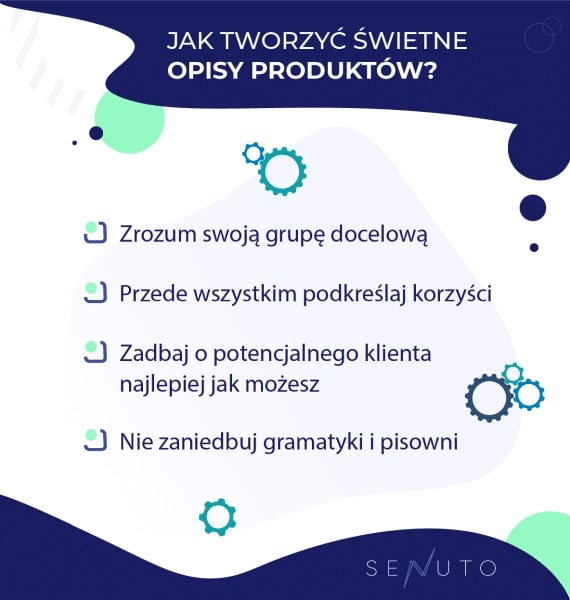
Before you get down to just creating a description,understand your target audience. This will help you apply yourself to the next step, which is keyword research. During such research, assist yourself with proven tools such as Senuto.
Prepare yourself a list of the most important product details, but don’t focus mainly on them. Put yourself in the customer’s shoes andemphasize the benefits above all. It will help you to tell an interesting story that the customer can relate to. However, remember to strike a balance with it – storytelling must target a specific audience, but you shouldn’t exclude other customers in its case.
Care for the potential customer as best you can – provide answers to the most important questions related to the product and include links to useful sources of information. Be sure to format your text properly to make your description the best it can be. Using an outline and running A/B tests to optimize the description will help you achieve the highest quality.
Don’t neglect grammar and spelling, as this can only scare customers away unnecessarily. Avoid excessive hype and don’t put too much emphasis on SEO, as the sales message will suffer. Use the description from the manufacturer, but don’t rely too heavily on it. Also, keep in mind your creative limits – descriptions must maintain a proper style. Prepare a draft for yourself and at the same time follow proven copywriting techniques like AIDA or 4U and remember – keep it simple, stupid 🙂
I hope that with these tips you will be able to create quality product descriptions that will translate into more sales.
 Daniel Podgórski
Daniel Podgórski